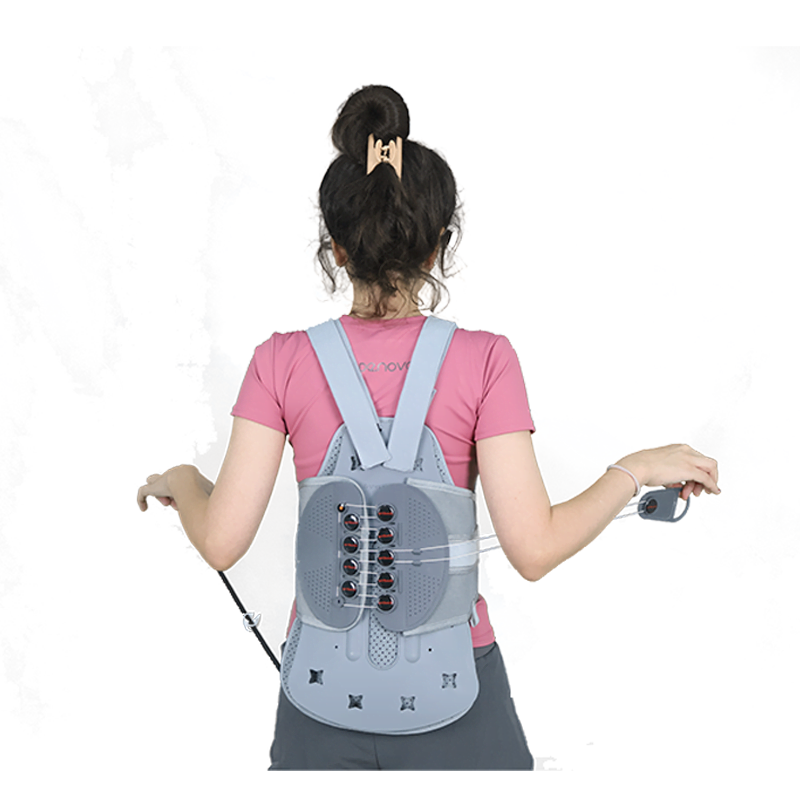Description
Introduction of the Orthopedic Back Lumbar Support
The Orthopedic Back Lumbar Brace is an advanced medical device engineered for exceptional support and alignment for lumbar vertebrae issues. It corrects poor posture, provides fixation for injuries, and offers protection during physical activities. Its design incorporates innovative features to guide the spine into natural alignment, reducing strain and promoting healing. The brace stabilizes injured areas, minimizing discomfort and reinjury risk. It also serves as a vital protective layer during workouts, sports, and daily tasks, safeguarding the lumbar spine and reducing pain.
Parameters of the Orthopedic Back Lumbar Support
| Model | DNOR-C27 |
| Material | Medical PE, Foam Fabric, Pulley System |
| Size | One Size Fits 22″-48″ Waistline |
| Color | White, Blue, Grey |
| Weight | 1.3kg |
| LOGO | A customized logo is accepted |
| Package | 1 x neutral opp bag |
| MOQ | Small order is accepted |
| Origin | Hebei |
| HS Code | 9021100000 |
| Production Capacity | 2000 PCS/Month |
Features of the Orthopedic Back Lumbar Support
Correct bending hump refused to bad shape
The Orthopedic Back Lumbar Brace is meticulously designed and crafted to address and effectively correct poor posture, including detrimental habits such as bending and hunching. These posture flaws can lead to a multitude of health issues, including spinal deformities and chronic pain, making it imperative to address them promptly and appropriately. By gently yet firmly encouraging an upright stance, the Orthopedic Back Lumbar Brace plays a pivotal role in preventing the progression of spinal deformities.
Curvature support board ergonomic design personal
At the core of the Orthopedic Back Lumbar Brace’s design is its innovative curvature support board, meticulously engineered with ergonomic principles to deliver exceptional, personalized support. By mimicking the spine’s natural shape, the curvature support board ensures that pressure is distributed evenly across the lumbar region, mitigating localized stress and reducing discomfort. The ergonomic design not only enhances comfort but also maximizes the effectiveness of the brace in providing targeted support where it is most needed.
Pulley mechanism
The inclusion of a pulley mechanism in the Orthopedic Back Lumbar Brace is a groundbreaking design element that significantly enhances its usability and effectiveness. This sophisticated feature allows users to effortlessly adjust the tension and fit of the brace, offering unparalleled flexibility and customization. By incorporating a pulley system, the brace can be tailored to the precise needs of each individual user, ensuring that it provides the perfect balance of support and compression.
Applications of the Orthopedic Back Lumbar Support
External/internal fixation of lumbar vertebra injury and soft tissue injury
External fixation of lumbar vertebra injury and soft tissue injury involves the use of braces, casts, or other devices applied to the outside of the body to stabilize the injured area. This method is often employed immediately after an injury to immobilize the affected lumbar region, prevent further damage, and facilitate healing. It helps maintain proper alignment, reduces pain, and supports the spine while the tissues heal. Internal fixation, on the other hand, involves surgical procedures where hardware such as screws, plates, and rods are used to stabilize the lumbar spine internally. This approach is typically utilized for more severe injuries, such as fractures or dislocations, where external fixation alone is insufficient. Internal fixation provides robust stability, allowing for better healing and a quicker return to normal activities.
Postoperative Assisted External Fixation for Lumbar Internal Fixation
Postoperative assisted external fixation for lumbar internal fixation involves utilizing external braces or supports after surgical procedures aimed at stabilizing the lumbar spine. These external devices play a crucial role in reinforcing the internal fixation hardware, such as screws and rods, that have been surgically implanted. By distributing stress away from the surgical site, these braces provide added support and protection during the critical healing phase, ensuring that the internal hardware remains securely positioned within the surrounding bone. This external support is vital for preventing complications, such as hardware failure or misalignment, which can jeopardize the success of the surgery. Ultimately, effective postoperative care through external fixation aids in the recovery process, helping patients regain mobility and function more quickly and safely.
Exercise Protection of Chronic Soft Tissue Diseases and Lumbar Osteoarthritis
Exercise protection for chronic soft tissue diseases and lumbar osteoarthritis focuses on using braces or supports during physical activities to alleviate stress on affected areas. Chronic soft tissue conditions, including muscle strains and ligament sprains, alongside lumbar osteoarthritis, can lead to considerable pain and limit mobility. By wearing supportive braces during exercise, individuals can remain active while significantly reducing the risk of reinjury or aggravating their existing conditions. These braces provide essential stability and support, allowing for safe participation in workouts or physical activities. This protective measure not only enables individuals to maintain their fitness routines but also promotes overall health and well-being, helping them manage pain and enhance their quality of life. With the right support, individuals can confidently engage in exercise, fostering resilience and recovery while protecting their joints and soft tissues.






Reviews
There are no reviews yet.